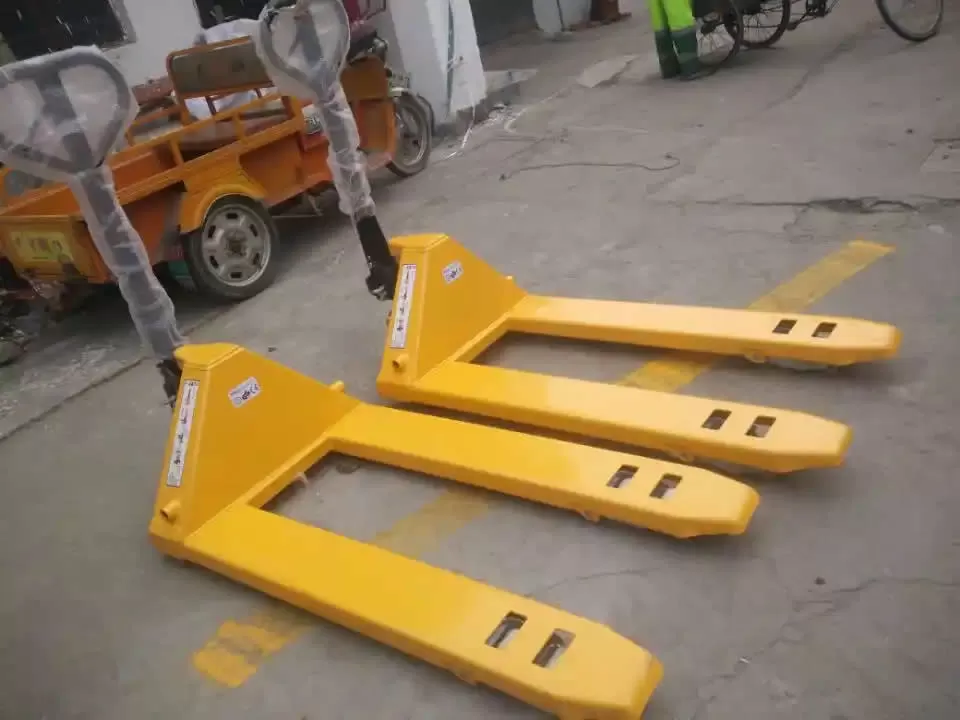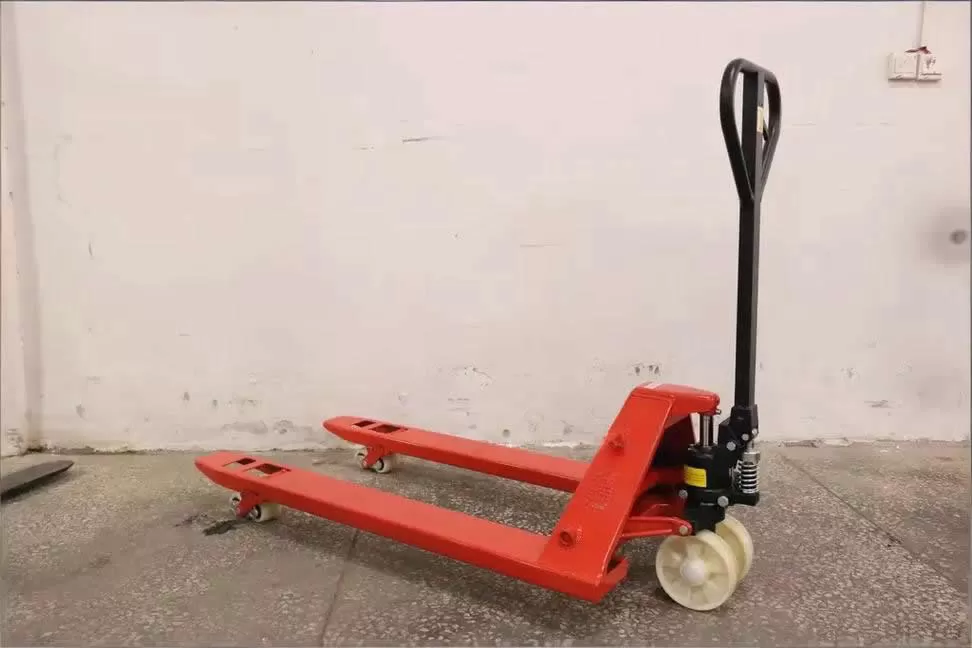Manual hydraulic pallet trucks are widely used material handling tools in warehousing, logistics, and manufacturing. Their main function is to easily raise and lower pallets using a hydraulic system, helping operators move heavy objects in limited spaces. To ensure smooth, efficient, and safe operation of the pallet truck, operators need to conduct regular inspections and follow relevant operating procedures. This article analyzes the daily inspection items and operational precautions for manual hydraulic pallet trucks from the perspective of a professional operator.

1.1 Hydraulic System Inspection
Oil Level Check: Hydraulic oil is crucial for ensuring the normal operation of the hydraulic system. Operators need to regularly check the hydraulic oil level in the tank to ensure it is within the specified range. If the hydraulic oil level is too low, it will cause unstable lifting and lowering of the pallet truck, or even render it unusable.
Oil Quality Check: The hydraulic oil should be kept clean, free of impurities and moisture. Check the oil's transparency; if the oil changes color or becomes cloudy, it should be replaced immediately.
Lifting Function: Under no-load conditions, repeatedly press the handle to observe whether the forks rise smoothly without shaking or abnormal noise. 1.1 Check the hydraulic cylinder for oil leaks; the oil level should be within the marked range.
Lowering Control: Slowly release the lowering valve to confirm that the forks descend at a uniform speed without sudden drops. If the lowering speed is abnormal, stop use immediately and report for repair.
1.2 Wheel and Caster Inspection
Wheel Wear Inspection: Wheels are an important component of the pallet truck. The operator should check the wheels for obvious wear, cracks, or deformation, ensuring smooth rotation during operation. If the wheels are severely worn or damaged, replace them promptly.
Caser Lubrication: Casters connect to the bottom of the pallet truck. After prolonged use, they may become stuck, affecting operational smoothness. Therefore, regular lubrication is necessary to ensure smooth rotation.
1.3 Handle and Operating System Inspection
Handle Function Inspection: Check the handle for looseness, bending, or damage, ensuring handle stability during operation.
Lifting System Inspection: The lifting system of a manual hydraulic pallet truck includes components such as a hydraulic pump and oil pipes. The operator should check whether the lifting handle can raise and lower smoothly and whether the hydraulic pump can effectively lift the load. Any excessive resistance or jamming requires adjustment or repair.
1.4 Safety Device Inspection
Safety Valve Inspection: Manual hydraulic pallet trucks are equipped with safety valves to prevent overloading or excessive load. Operators should regularly check the safety valves to ensure they are functioning properly and can protect the hydraulic system in case of overload. Test the response speed by pressing the emergency descent button to ensure rapid load unloading in emergencies.
Brake System Inspection: If the pallet truck is equipped with a braking system, the operator needs to check the brake function to ensure the vehicle is stably fixed when stopped.
Handle Protection: Check that the handle anti-slip sleeves are intact and that there is no risk of the control lever positioning pins falling off.
1.5 Overall Structural Inspection
Inspect the Pallet Truck Frame and Connectors: The pallet truck frame should be sturdy and free of cracks or deformation. Connectors and screws should be checked regularly for looseness and tightened if necessary to avoid safety hazards during operation.
Body and Forks: Inspect the forks for cracks or deformation and confirm that there are no cracks in the welded areas. The vehicle body surface should be clean and free of oil stains to prevent slippage during operation.
Wheels and Steering: Rotate all wheels to ensure there is no jamming, and check tire wear. Steering wheels should return to center smoothly without looseness or abnormal noise.

2.1 Loading Specifications
Weight Distribution: The center of gravity of the goods should be centered. A single load must not exceed the rated load (common models are 2-3 tons). Long items should be placed horizontally to avoid top-heavy loading.
Stacking Safety: The forks must be fully inserted into the pallet slots; partial insertion is strictly prohibited. When stacking multiple layers, ensure the bottom pallet has the required load-bearing capacity.
2.2 Load Requirements
Adhere to Rated Load Capacity: Each manual hydraulic pallet truck has a specified maximum load capacity. Operators must strictly adhere to this specification when using the pallet truck to avoid overloading, which could damage the hydraulic system or cause operational instability.
Evenly Distribute Goods: Goods should be evenly placed on the pallet to ensure load balance. Avoid excessive weight on one side, which could lead to instability or tipping over of the pallet truck.
2.3 Lifting Operation
Slow Lifting: During lifting, operators should avoid rapid or forceful operations, and lift the pallet as slowly and smoothly as possible. Sudden lifting increases the burden on the hydraulic system and may even lead to hydraulic oil leaks or lifting malfunction.
Lifting to the Definite Height: Ensure the pallet reaches the required height smoothly when lifting the pallet truck, avoiding mid-operation pauses or overlifting, which could cause goods to tilt or fall.
2.4 Operating Environment
Smooth Ground Operation: Operators should choose flat, firm ground for operation whenever possible, avoiding using the pallet truck on potholes, slippery, or uneven ground to reduce the risk of tilting and accidents.
Avoid Impacts: During handling, avoid impacts to the pallet truck's casters, wheels, or other parts. Violent impacts can not only damage the pallet truck but may also damage surrounding goods or facilities.
Confined Spaces: In areas where the aisle width is less than 1.5 times the truck's length, use a "forward and backward" fine-tuning movement to avoid sharp turns and collisions with obstacles.
Ground Conditions: Promptly clear debris and debris from the travel route. Pass smoothly over steel plate joints to minimize impact on the hydraulic system.
2.5 Pushing the Manual Hydraulic Pallet Truck
Avoid Sudden Pushing and Pulling: When pushing or pulling the pallet truck, the operator should avoid using excessive force or sudden exertion. Push smoothly, especially under heavy loads, to avoid sudden inertial forces impacting the hydraulic system.
Direction Control: The operator should always maintain control of the pallet truck to prevent loss of control, collisions, or tipping.
2.6 Post-Use Handling
Returning and Cleaning: After each use, the operator should return the manual hydraulic pallet truck to its original position and clean any stains or water from the truck to maintain cleanliness. This is especially important in humid environments to prevent corrosion of the hydraulic system and wheels due to moisture ingress.
Inspection: Even after the pallet truck is no longer in use, the operator should periodically inspect its condition to ensure no damage or component aging occurs after long-term storage.
3.1. Daily Maintenance Requirements
Periodic Maintenance: Clean the chain and bearings after each shift. Lubricate rotating parts weekly. When not in use for extended periods, depressurize to the lowest possible level before storage.
Record Management: Establish an inspection log and keep monthly records of critical components such as hydraulic system seals and wheel bearings.
3.2 Handling Abnormal Situations
Sudden Failure: If the forks fail to lift or the handle operating force increases dramatically, immediately stop use and display a "Faulty and Awaiting Repair" sign.
Leakage Emergency: If a hydraulic oil leak is detected, cover it with absorbent cotton to prevent contamination of the work area and report it to maintenance immediately.
Manual hydraulic pallet trucks are indispensable tools in modern warehousing and logistics. Their normal operation depends on meticulous inspection and standardized operation by the operator. By regularly inspecting the hydraulic system, wheels, lifting device, and safety devices, operators can effectively extend the service life of the pallet truck and prevent accidents.
At the same time, strictly adhering to load requirements, operating procedures, and environmental conditions during operation is crucial to ensuring the safe and efficient use of the pallet truck. We hope that all operators will remain vigilant in their daily work, and ensure early inspection, early detection, and early resolution of problems, so as to guarantee safe and efficient material handling.